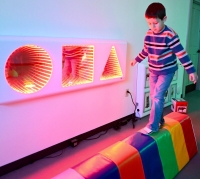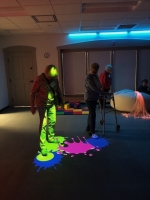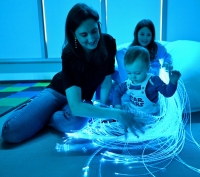Sensory Friendly Spaces and Services
Public Library of Youngstown and Mahoning County
Innovation Synopsis
PLYMC created a dedicated sensory space and outdoor sensory play area at the Boardman branch and is developing programs and building connections with the special needs community. The Sensory Room is adaptable to users’ needs and is a community resource for individuals with sensory aversion or sensory seeking behaviors. It has been used by both families and groups, including students from a special needs school and residents from a nursing home. To welcome the special needs community into our Library, public service staff completed training on autism and supporting individuals with disabilities. In addition to the sensory spaces, we have introduced sensory friendly programs, including storytimes and adapted book clubs for adults. We are reaching new Library users and we are learning about their needs. Staff are establishing new relationships with the special needs community and are developing programs and services to meet their needs.
Challenge/Opportunity
According to the KIDS COUNT Data Center, the number of children who have one or more emotional, behavioral, or developmental condition in Ohio has been trending upward, from 482,886 in 2017/18 to 549,872 in 2019/20, an increase of 14 percent over the two-year period. These numbers include children ages 3 to 17 with a parent who reports that a doctor has told them that their child has autism, developmental delays, depression or anxiety, ADD/ADHD, or behavioral/conduct problems. U.S. Census data shows that there are 9,936 individuals over age 5 in Mahoning County with a sensory disability. This represents 4.2 percent of Mahoning County’s total population of 236,807. With families of these individuals considered, this is a significant part of our population who experience challenges in accessing library services. We strive to welcome and serve all members of our community with empathy, respect, and dignity.
Key Elements of Innovation
Dedicated sensory equipment and spaces meet a specific need in our community. The Sensory Room also introduces the library to the special needs community through these services. Through conversations and knowledgeable staff, we are growing these relationships and increasing Library services to this population.
Sensory Room Equipment:
• Interactive Motion Activated Projector
• Bubble Tube
• Fiber Optic Softie
• Musical Touch Wall
• Vibro-Acoustic Platform
• Sound Wall
• Infinity Tunnel and Balance Beam
• Wobble Disk
Outdoor Sensory Play Area Equipment:
• Playhouse
• Harmony Bells
• Petal Drums
Sensory Programming
• Small groups
• Visual schedules
• Fidgets and scalable activities
• In partnership with the Autism Society of Mahoning Valley
Staff Training
• All public service staff completes the online course “Faces of Autism”
• The Educational Services Center Students With Disabilities team trained Boardman staff and at our library system-wide staff day
Achieved Outcomes
The Sensory Room was used 660 times this past year. Surveys show that 100% of users strongly agree the space is valuable and plan to use it again. 25% state this was the first time they used the Library; 85% said the availability of the sensory room contributed to their decision to use the Library. These survey results, along with conversations, tell us that we are reaching new Library users and providing a valued service. Over the past year, we have offered 64 sensory friendly programs at three Library branches. Surveys and conversations report that families value the opportunity to attend programs and interact with other families. Recently, we became the primary distribution partner for the County Prosecutor’s Blue Envelope program. Blue Envelopes assist in communication during a traffic stop or police interaction for individuals who have physical, mental, or developmental disabilities, are deaf or hard of hearing, or nonverbal. Connections with this community continue to grow.
Additional Materials:



